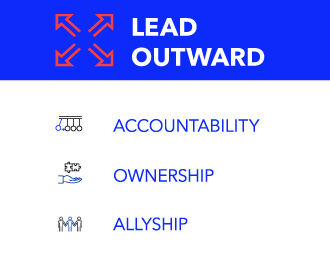
While you may be confident in your ability to deliver on business goals, creating a cohesive team where everyone is excited to contribute and innovate can be more challenging. Building an inclusive team culture is key. Catalyst surveyed over 2,100 employees at large corporations — most of whom worked in one of eight countries across five continents — to look deeply at drivers of inclusion. Our findings show that a manager’s behavior has a direct link to an employee’s experience of inclusion — in fact, almost half of an employee’s experience of inclusion can be explained by managerial inclusive leadership behaviors.
And what are the manager behaviors that predict inclusion? We tested that, too — and we uncovered a model of inclusive leadership that balances both leading outward and leading inward.
Key Findings:
1. Catalyst’s inclusive leadership model powerfully predicts inclusion among employees in a diverse cross-section of countries and populations.
- 45% of employee experiences of inclusion are explained by their manager’s inclusive leadership behaviors.
2. Our model features two complementary dimensions and six core behaviors.


3. The five hallmarks of inclusion:
- Valued: You are appreciated and respected for your unique perspectives and talents.
- Trusted: You make meaningful contributions and are influential in decision-making.
- Authentic: You can bring your full self to work and express aspects of yourself that may be different from your peers
- Psychological Safety – Latitude: You feel free to hold differing views and make
mistakes without being penalized. - Psychological Safety – Risk-taking: You feel secure enough to address tough issues or take risks.
4. Positive experiences of inclusion benefit both employees and employers. These experiences of inclusion explain:

TEAM PROBLEM-SOLVING
An employee’s view of how well their team works together constructively to find solutions to problems and resolve conflicts.

WORK ENGAGEMENT
An employee’s emotional investment in their work and the company’s mission.

INTENT TO STAY
An employee’s interest in remaining with the organization.

EMPLOYEE INNOVATION
An employee’s ability to generate new ideas, processes, and approaches to achieving goals.
This report is a call to action to take hard look at how we lead and who we are in order to drive inclusion.
How to cite this product: Dnika J. Travis, Emily Shaffer, and Jennifer Thorpe-Moscon, Getting Real About Inclusive Leadership: Why Change Starts With You (Catalyst, 2019).